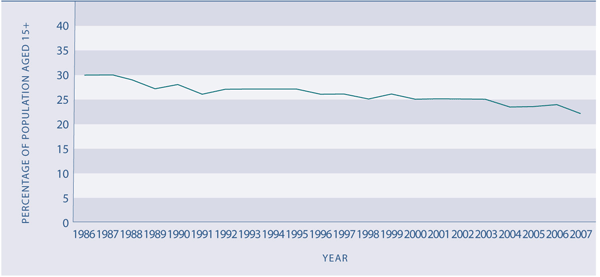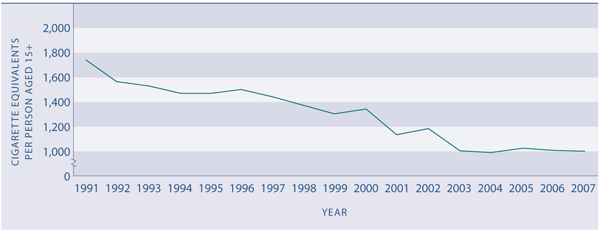Cigarette smoking
Definition
The proportion of the population who currently smoke cigarettes. Up to 2005, the survey population was people aged 15 years and over (ACNielsen survey). From 2006, the survey population is people aged 15–64 years (New Zealand Tobacco Use Survey, New Zealand Health Survey).
Relevance
Tobacco smoking is a well-recognised risk factor for many cancers and for respiratory and cardiovascular diseases. In addition, exposure to environmental tobacco smoke (particularly maternal smoking) is a major risk factor for Sudden Infant Death Syndrome and respiratory problems in children. Smoking has been identified as the major cause of preventable death in OECD countries.29
Current level and trends
In 2006/2007, 22 percent of people aged 15–64 years were cigarette smokers, according to the New Zealand Health Survey. This is below the 24 percent derived from the New Zealand Tobacco Use Survey conducted in the first quarter of 2006.
Long-term trends are available only for the population aged 15 years and over. For this population, smoking prevalence fell to 19.9 percent in 2006/2007. This was below the 24 percent derived from the ACNielsen survey for 2005 and the lowest level in over three decades. Among the population aged 15 years and over, smoking has declined from 30 percent in 1986, with most of the decline occurring between 1987 and 1991.
It is important to note that there are methodological differences between these three surveys and some caution should be used when comparing figures. Ongoing monitoring in the social report will be based on the New Zealand Tobacco Use Survey. As this survey is carried out in two out of every three years, it allows the most frequent updates.
Figure H4.1 Prevalence of Cigarette smoking, 1986–2007

Source: Ministry of Health
Notes: (1) Data not standardised for age (2) 1986–2005: population aged 15+ years; 2006, 2007: population aged 15–64 years
Age and sex differences
Smoking rates for females and males have been similar since the mid-1980s.
In 2006/2007, 23 percent of males and 21 percent of females smoked. However, this sex difference was not statistically significant.
In 2006/2007, smoking was most prevalent among people aged 25–34 years, followed by those aged 15–24 years. People aged 55–64 years had a significantly lower smoking prevalence than younger age groups. Since the mid-1980s, people aged 55 and over have experienced the greatest decline in smoking prevalence.30
Daily smoking rates for 14–15 year olds have declined considerably since 1999.
Between 1999 and 2006, the prevalence of daily smoking declined by 56 percent for males in this age group (from 14 percent to 6 percent) and by 42 percent for females (from 17 percent to 10 percent).
Ethnic differences
Smoking prevalence is significantly higher among Māori and Pacific peoples, at around 44 percent and 28 percent respectively, than among the total population aged 15–64 years in 2006/2007. It is significantly lower among Asian ethnic groups (12 percent) in that year. Among Māori, the prevalence of smoking is significantly higher for women than for men. The opposite is the case among Pacific peoples and Asians. European women and men have similar smoking rates.
Since 1990, smoking prevalence has declined by seven percentage points for Māori and by three percentage points for the European/Other ethnic groups.31
Table H4.1 Age-standardised prevalence (%) of cigarette smoking, by sex and ethnicity, 2006/2007
| |
Percentage in each ethnic group who smoke cigarettes |
| European/Other |
Māori |
Pacific peoples |
Asian |
Total |
| Male |
22.3 |
40.3 |
34.5 |
19.4 |
23.4 |
| Female |
21.1 |
47.3 |
21.8 |
5.3 |
20.9 |
| Total |
21.7 |
44.1 |
27.9 |
11.9 |
22.1 |
Source: Ministry of Health (2008d)
Notes: (1) Rates are age-standardised using the WHO world population (2) People who reported more than one ethnic group are counted once in each group reported
Socio-economic differences
In 2006/2007, the smoking prevalence rate in the most deprived areas (NZDep2006 deciles 9–10) was 2.8 times the rate in the least deprived areas (deciles 1–2).32
International comparison
In an OECD comparison of daily smoking rates for adults aged 15 years and over, New Zealand had a rate of 21 percent in 2006, compared with an OECD median of 24 percent.33 New Zealand ranked seventh lowest out of 30 OECD countries. Smoking prevalence was highest in Greece (39 percent in 2004) and lowest in Sweden (16 percent in 2005). New Zealand’s rate was lower than that of the United Kingdom (22 percent in 2006), but higher than those of Australia (18 percent in 2004), the United States and Canada (both 17 percent in 2006 and 2005 respectively). Compared to other OECD countries, New Zealand’s smoking levels are relatively low for males and relatively high for females.34
Tobacco consumption
In 2007, tobacco consumption was 1,002 cigarette equivalents per person aged 15 years and over, down slightly from 1,006 in 2006. Since 1991, tobacco consumption has decreased by 42 percent. Over this period, the drop in tobacco consumption has been more rapid than the drop in smoking prevalence.
Figure H4.2 Tobacco consumption, cigarette equivalents per person aged 15 years and over, 1991–2007

Sources: Ministry of Health (2006c) Table D1; Statistics New Zealand (2008a)
|


